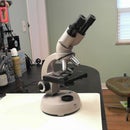Introduction: How to Make a Light Bulb Changer on a Stick From What Other People Call Garbage
So if necessity is the mother of invention, then in my case, the father is stinginess... and when they have a mutant baby, it looks like this picture...
What actually happened is: I was walking out to my car to drive the the hardware store and buy a light bulb changer on a stick, as I hadn't been able to come up with a suitable solution to the fact that I have 6 floodlights to put up, all in places that would require a really really tall ladder (which I don't own) or a light bulb-holder-stick contraption (which I also did not own). I had looked at the light bulb changers online, and they seemed fairly simple, either they were an array of suction cups that gripped the smooth glass on the front of the flood light, or they had some robot -hand-looking spring metal and rubber gripper. I was dubious about the quality of either of these in terms of actually holding onto the light bulb hard enough to turn it in place, but still be able to disengage it at a distance without pulling the fixture down or breaking something. I was thinking there needed to be a middle ground between the suction cup and the grippy-claw thing, but what would that look like?
On my way out to the car, I was taking the trash out as well and noticed through the bag this little can that had once housed delicious green chilis, and BAM! I had a moment. A few minutes later the bastard child of necessity and stinginess was born.
Step 1: Ingredients
For this project I used:
- Trader joe's green chili can (minus the delicious green chili)
- a gob of beeswax
- M3 15mm screw, washer and locking nut
- an improbably long curtain rod
- Duct tape
Step 2: Assembly
I don't know why I have a lump of beeswax, but I do... Anyone who knows me will tell you that it is normal for me to have such things lying around. Happily, it was exactly what I needed for this project. I imagine there are plenty of substitutes, even ones that would work better. Essentially, all it was doing was providing some tackiness and a way to seal the "suction cup." I was kind of in a hurry anyway, so instead of looking for the ideal material, I used what I had on hand.
I coated the rim of the can in a bead of wax and smushed it around as evenly as I could.
I then used a punch to poke a hole in the center for the screw.
The curtain rod I had found in the attic portion above the garage and had come with the house, conveniently had snug-fitting plastic end caps which I used to attach my gripper cup.
I just drilled a small hole and used the M3 15mm screw and locking nut to attach the plastic cap to the "suction gripper." I used a little bit of wax around the hole before tightening it down in order to protect any seal I might be able to get with the can.
Even though it is a metal food can, it actually is pretty pliable, especially the bottom where I would be attaching the pole. It had significant enough give (and rebound) to create suction when pressed inward, provided there was some way to seal the edges.
Step 3:
Now we take our newly assembled "suction gripper" and put it on the end of our hilariously long curtain rod (seriously, who has 14ft wide windows?). Liberal application of duct tape is advised. What isn't pictured well here is that I wrapped the duct tape around, not only the plastic cap to the pole, but also the bottom half of the can to the pole. If you don't do this, then when you try to screw the light bulb in, it will just spin on the screw.
I also duct taped the joint between the two halves of the curtain rod where it extends.
Step 4: Light Bulbs on a Stick!
Now just add light bulbs and voila!
Three cheers for re-purposed trash!
I was easily able to put up all 6 lights without issue, and now I have a light bulb changer on a stick of my very own.
One thing to note, I was initially putting them in with the fixtures turned on so that I could see the light light-up and know that I was screwing it in properly. Except for the fact that these lights heat up... fast, which then started melting my wax gripper. So I had to screw them in with it off and then turn it on afterward. Small detail that ended up not really being a problem.













